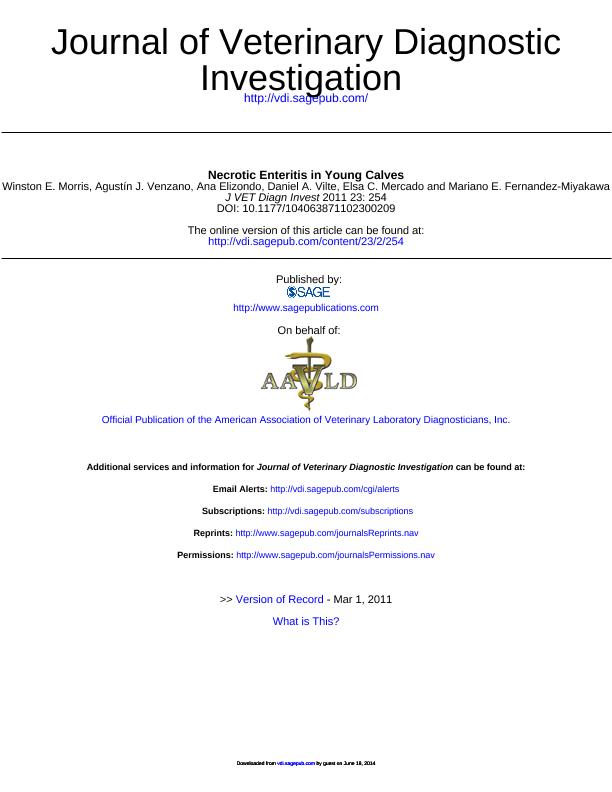Artículo
Necrotic enteritis in young calves
Morris, Winston Eduardo; Venzano, Agustín J.; Elizondo, Ana; Vilte, Daniel Alejandro; Mercado, Elsa Cristina; Fernandez Miyakawa, Mariano Enrique

Fecha de publicación:
03/2011
Editorial:
American Association of Veterinary Laboratory Diagnosticians
Revista:
Journal of Veterinary Diagnostic Investigation
ISSN:
1040-6387
Idioma:
Inglés
Tipo de recurso:
Artículo publicado
Clasificación temática:
Resumen
Non-enterotoxin (CPE)-producing Clostridium perfringens type A has been associated with enteritis in calves. Recent evidence has suggested that a novel toxin, named beta2 (CPB2), is implicated in the pathogenesis of this disease, although there is little evidence supporting this. In the current study, the role of C. perfringens type A in an outbreak of enteritis in calves was studied. Two 20-day-old dairy calves exhibiting apathy and reluctance to eat, with paresis of the anterior limbs, were euthanized for postmortem examination. Gross and histological changes compatible with acute enteritis, rumenitis, meningitis, and pneumonia were seen in both calves. Clostridium perfringens type A non-CPE, non-CPB2 was isolated from the abomasum and the small intestine. Escherichia coli ONT:H8 (with cdtBIII and f17 virulence genes detected by polymerase chain reaction) was also isolated from the brain, abomasum, and intestine from both calves. All the samples were negative for Salmonella spp. When the C. perfringens strain was inoculated into bovine ligated small and large intestinal loops, cell detachment, erosion, and hemorrhage of the lamina propria were observed, predominantly in the small intestine. The results suggest that non-CPE, non-CPB2 C. perfringens type A is able to induce pathologic changes in the intestine of calves, probably enhanced by other pathogens, such as some pathogenic E. coli strains.
Palabras clave:
CALVES
,
CLOSTRIDIUM PERFRINGENS
,
ENTERITIS
,
LOOP
Archivos asociados
Licencia
Identificadores
Colecciones
Articulos(SEDE CENTRAL)
Articulos de SEDE CENTRAL
Articulos de SEDE CENTRAL
Citación
Morris, Winston Eduardo; Venzano, Agustín J.; Elizondo, Ana; Vilte, Daniel Alejandro; Mercado, Elsa Cristina; et al.; Necrotic enteritis in young calves; American Association of Veterinary Laboratory Diagnosticians; Journal of Veterinary Diagnostic Investigation; 23; 2; 3-2011; 254-259
Compartir
Altmétricas



